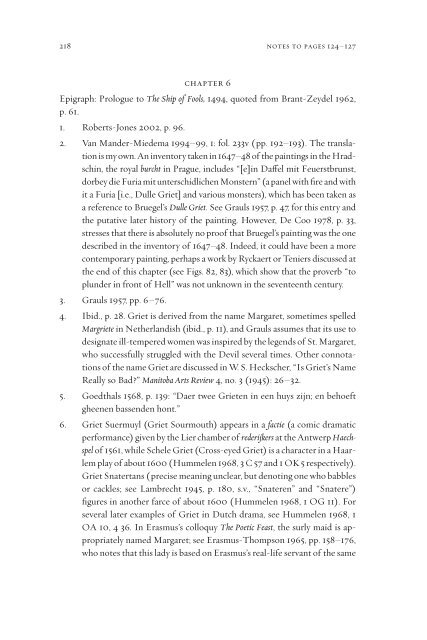Pieter Bruegel and the Art of Laughter - AAAARG.ORG
Pieter Bruegel and the Art of Laughter - AAAARG.ORG
Pieter Bruegel and the Art of Laughter - AAAARG.ORG
You also want an ePaper? Increase the reach of your titles
YUMPU automatically turns print PDFs into web optimized ePapers that Google loves.
218 notes to pages 124–127<br />
chapter 6<br />
Epigraph: Prologue to The Ship <strong>of</strong> Fools, 1494, quoted from Brant-Zeydel 1962,<br />
p. 61.<br />
1. Roberts-Jones 2002, p. 96.<br />
2. Van M<strong>and</strong>er-Miedema 1994–99, 1: fol. 233v (pp. 192–193). The translation<br />
is my own. An inventory taken in 1647–48 <strong>of</strong> <strong>the</strong> paintings in <strong>the</strong> Hradschin,<br />
<strong>the</strong> royal burcht in Prague, includes “[e]in Daªel mit Feuerstbrunst,<br />
dorbey die Furia mit unterschidlichen Monstern” (a panel with fire <strong>and</strong> with<br />
it a Furia [i.e., Dulle Griet] <strong>and</strong> various monsters), which has been taken as<br />
a reference to <strong>Bruegel</strong>’s Dulle Griet. See Grauls 1957, p. 47, for this entry <strong>and</strong><br />
<strong>the</strong> putative later history <strong>of</strong> <strong>the</strong> painting. However, De Coo 1978, p. 33,<br />
stresses that <strong>the</strong>re is absolutely no pro<strong>of</strong> that <strong>Bruegel</strong>’s painting was <strong>the</strong> one<br />
described in <strong>the</strong> inventory <strong>of</strong> 1647–48. Indeed, it could have been a more<br />
contemporary painting, perhaps a work by Ryckaert or Teniers discussed at<br />
<strong>the</strong> end <strong>of</strong> this chapter (see Figs. 82, 83), which show that <strong>the</strong> proverb “to<br />
plunder in front <strong>of</strong> Hell” was not unknown in <strong>the</strong> seventeenth century.<br />
3. Grauls 1957, pp. 6–76.<br />
4. Ibid., p. 28. Griet is derived from <strong>the</strong> name Margaret, sometimes spelled<br />
Margriete in Ne<strong>the</strong>rl<strong>and</strong>ish (ibid., p. 11), <strong>and</strong> Grauls assumes that its use to<br />
designate ill-tempered women was inspired by <strong>the</strong> legends <strong>of</strong> St. Margaret,<br />
who successfully struggled with <strong>the</strong> Devil several times. O<strong>the</strong>r connotations<br />
<strong>of</strong> <strong>the</strong> name Griet are discussed in W. S. Heckscher, “Is Griet’s Name<br />
Really so Bad?” Manitoba <strong>Art</strong>s Review 4, no. 3 (1945): 26–32.<br />
5. Goedthals 1568, p. 139: “Daer twee Grieten in een huys zijn; en behoeft<br />
gheenen bassenden hont.”<br />
6. Griet Suermuyl (Griet Sourmouth) appears in a factie (a comic dramatic<br />
performance) given by <strong>the</strong> Lier chamber <strong>of</strong> rederijkers at <strong>the</strong> Antwerp Haechspel<br />
<strong>of</strong> 1561, while Schele Griet (Cross-eyed Griet) is a character in a Haarlem<br />
play <strong>of</strong> about 1600 (Hummelen 1968, 3 C 57 <strong>and</strong> 1 OK 5 respectively).<br />
Griet Snatertans ( precise meaning unclear, but denoting one who babbles<br />
or cackles; see Lambrecht 1945, p. 180, s.v., “Snateren” <strong>and</strong> “Snatere”)<br />
figures in ano<strong>the</strong>r farce <strong>of</strong> about 1600 (Hummelen 1968, 1 OG 11). For<br />
several later examples <strong>of</strong> Griet in Dutch drama, see Hummelen 1968, 1<br />
OA 10, 4 36. In Erasmus’s colloquy The Poetic Feast, <strong>the</strong> surly maid is appropriately<br />
named Margaret; see Erasmus-Thompson 1965, pp. 158–176,<br />
who notes that this lady is based on Erasmus’s real-life servant <strong>of</strong> <strong>the</strong> same












